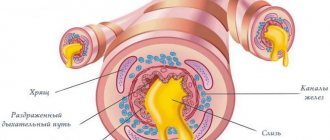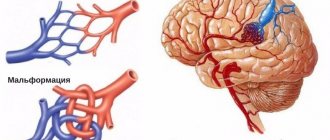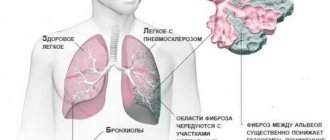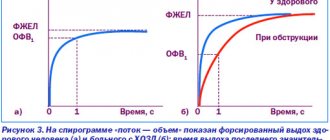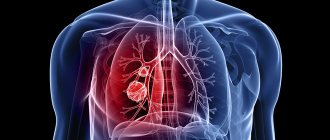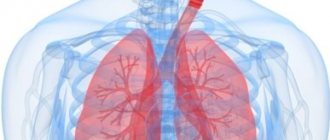What is smoker's bronchitis and what causes it?
This is an independent disease of a chronic nature, caused by constant smoking and inhalation of elements of tobacco smoke. Upon reaching adulthood (35 years or more), the symptoms become more pronounced, and the course of the disease itself is determined by the number of cigarettes smoked per day and the length of smoking.
The development of pathology occurs due to burns of the bronchial mucosa by tobacco smoke, as a result of which active growth and reproduction of pathogenic microflora begins in the damaged areas. In addition, the poisons contained in tobacco smoke lead to intoxication of the body and weakened immunity.
The disease develops when a combination of the following factors:
- unfavorable environmental conditions in the region of residence;
- the presence of chronic pathologies;
- long history of smoking;
- number of cigarettes smoked per day;
- professional activity;
- state of the immune system.
The most severe symptoms of smoker's bronchitis are observed at the age of 60−65 years. By this time, periods of exacerbation of the disease are clearly visible, lasting at least three months a year and manifested by a severe cough with sputum production .
Symptoms of the disease
In people who smoke, work in hazardous industries or live in large industrial cities, symptoms of smoker's bronchitis appear much earlier than in cigarette lovers living in regions with a favorable environmental situation. In addition, in the former, the pathology is more aggressive, and sputum production is difficult.
Bronchitis of this type has one interesting feature: it can develop not only in the smoker himself, but also in the people around him who are regularly forced to inhale smoke (so-called passive smoking).
The course of the disease can be divided into three stages.
The first is characterized by a morning cough and has the following symptoms:
- Not a daily mild cough that gradually gets worse.
- Over time, when coughing, viscous sputum appears, which may be brown in color, have purulent inclusions or streaks.
- Moderate physical activity causes shortness of breath.
- Against the background of weakened immunity, smokers more often develop viral pathologies, which are quite difficult to tolerate and are accompanied by severe coughing attacks.
The second stage of the disease is characterized by morphological changes, which are manifested by the following symptoms:
- A sharp breath causes coughing attacks.
- Light and moderate physical activity provokes shortness of breath during inhalation. Sometimes fainting occurs.
- In strong winds, as well as in cold air, arrhythmia and shortness of breath appear when exhaling.
The third stage of development of the disease is associated with the onset of chronic obstructive pulmonary disease. At this stage of the disease, symptoms such as a constantly present hacking cough with sputum production, difficulty breathing when lying down, severe shortness of breath even with minimal physical activity, and the development of concomitant diseases provoked by chronic oxygen deficiency are noted.
The pathology is accompanied by abnormal inflammation of the lung tissue, which leads to disability, and a complicated form can cause death. A characteristic feature of this pathology is the presence of irreversible, constantly increasing changes in all systems and internal organs. This condition is caused by respiratory failure, as a result of which organs and tissues lack oxygen.
Why is bronchitis from smoking dangerous?
The development of pathology threatens the following consequences:
- disturbances of all metabolic processes in the body;
- weakening of visual function, development of cataracts;
- decreased immunity, because of this, even the most common cold becomes severe and difficult to treat;
- deterioration of brain activity, characterized by such manifestations as impaired coordination of movement, memory loss, drowsiness, chronic fatigue, dizziness, irritability.
Diagnostic measures
Diagnosis and treatment of this dangerous disease is carried out by a pulmonologist who specializes in diseases of the respiratory tract.
After carrying out preliminary diagnostic measures - visual examination, listening to the bronchi and lungs , the specialist prescribes the following examinations to the patient:
- Fluorography. It is a basic research method that is carried out to exclude the presence of diseases other than bronchitis - emphysema, cancer, tuberculosis.
- Bronchoscopy. The doctor, using a bronchoscope, examines the mucous membrane of the trachea and bronchi.
- Spirogram is a study of external respiration parameters. A special test (spirometry) is performed, which determines lung volume, the amount of exhaled air and other indicators necessary to make an accurate diagnosis.
- Blood tests (general and biochemical). During the study, the specialist analyzes the total level of leukocytes and the erythrocyte sedimentation rate. This will allow us to determine the presence or absence of hidden inflammatory processes in the smoker’s body. Later stages of the disease are characterized by an increase in hemoglobin. In this way, the body tries to restore and compensate for the lack of gas exchange.
- Analysis of secreted sputum with a sensitivity test to antibacterial agents and bacterial culture.
What is smoker's bronchitis?
Smoker's bronchitis occurs in a latent form and slowly.
Breathing depends on the functioning of the bronchi. The bronchi look like even and smooth vesicles that are intended for:
- removing bacteria and dust from the lungs that are inhaled;
- the flow of air to the lungs and, accordingly, oxygen into the blood.
The term smoker's bronchitis itself does not exist in the medical sense. This is the cause of bronchitis.
Pulmonologists generally make a diagnosis of obstructive bronchitis with this diagnosis.
The severity of this disease lies in the fact that it:
- affects the entire bronchial system;
- progresses in a latent form and slowly.
When a patient comes to see a doctor, he has an advanced form of the disease. Obstruction is a severe stage of bronchitis, in which the bronchi are unable to perform their task because their cells are severely damaged.
A common cough when smoking should not be confused with smoker's bronchitis. You can get rid of the first by simply stopping smoking, but with bronchitis, the desire to quit smoking will not help.
At this stage, the disease enters a progressive stage, which can be fatal.
Treatment of chronic bronchitis
The effectiveness of therapy directly depends on the will of the smoker. He needs to give up his bad habit of smoking forever. The main focus of the treatment course is the elimination of respiratory failure.
Medications
Bronchodilators. The action of these drugs is aimed at relieving respiratory failure and combating factors that provoke narrowing of the bronchi . The doctor, after analyzing the patient’s condition, may prescribe the following bronchodilators:
- Adrenergic agonists. Medications that relieve attacks of respiratory failure by weakening the bronchial muscles. These may be medications such as Ephedrine, Salbutamol, Isoprenaline, Fenoterol, Epinephrine.
- Phosphodiesterase inhibitors. Drugs whose action is aimed at weakening the muscles of the bronchi, resulting in a reduction in the number of calcium ions, which improves lung ventilation. However, be careful - such drugs have a number of side effects, the main of which are low blood pressure and dizziness. The group of inhibitors includes drugs such as Theophylline, Theobromine and Euphylline.
- Corticosteroids. Prescribed for severe forms of smoker's bronchitis: Triamycinolone, Prednisolone, Dexamethasone, Beclomethasone, Hydrocortisone.
Smoker's chronic bronchitis - symptoms and treatment
The irritating effects of tars, nicotine, and flavorings negatively affect the entire bronchopulmonary system. The human respiratory tract is lined with tiny cilia. These hairs purify the air going into the lungs.
Nicotine paralyzes the work of the cilia, as a result, toxins and toxic substances penetrate into the lungs, where they accumulate and provoke the development of inflammation. This process leads to the appearance of a cough - the body strives with all its might to get rid of harmful substances. Smoker's bronchitis occurs.
The first signs of smoker's bronchitis are observed at 35-40 years of age . And the disease reaches its peak at 60-65 years. Moreover, non-smokers who permanently live with a habitual smoker may also suffer. The lungs of “passive” smokers suffer no less!
How dangerous is the condition?
Chronic inflammation of the bronchi in combination with constant respiratory failure in smokers leads to disastrous consequences:
- chronic fatigue;
- fast fatiguability;
- oxygen starvation;
- problems in the functioning of internal organs;
- pathological deformations of the respiratory system;
- development of obstructive pulmonary disease (COPD).
Such consequences, which threaten the life and health of a smoker, are guaranteed if he has a frivolous attitude towards himself and an unwillingness to treat the underlying disease - bronchitis. How to recognize the onset of a pathological situation, and which doctor to go to?
Symptoms of smoker's bronchitis
does not develop immediately in smokers . The picture of pathology consists of three main signs. Doctors divide smoker's bronchitis into three stages, as symptoms develop:
| Symptom | Stage 1 | Stage 2 | Stage 3 (COPD) |
| Cough | The morning cough is dry, not strong, and does not occur every morning. The cough gradually becomes annoying and constant | The cough turns into a wet type, appears when inhaling | The cough is constant, strong and painful, paroxysmal, worsens with wind and cold air |
| Sputum | No sputum | The sputum is viscous, yellow-brown in color, a slight inclusion of purulent streaks can be seen in the mucus | Thick brown sputum with abundant purulent inclusions |
| Dyspnea | Shortness of breath develops during mild physical exertion (walking up the stairs to the 4th-5th floors, not long running) | Shortness of breath becomes inspiratory (occurring during inspiration), appears with moderate physical activity, gradually intensifies, leading the person to a semi-fainting state. | Severe shortness of breath, which occurs even with light exertion and even at rest, is accompanied by increased heartbeat (tachycardia), can cause loss of consciousness, and oxygen deprivation is noted |
In 80-90% of cases, chronic bronchitis of a smoker causes COPD . Chronic obstructive pulmonary disease is a progressive disease that permanently restricts the airflow into the lungs.
The pathology occurs with abnormal inflammatory processes in the lung tissue and leads the patient to disability, and in severe cases to death.
Drugs for the treatment of smoker's bronchitis
At an early stage, outside periods of exacerbation, the disease does not require drug therapy. It is enough to quit smoking and walk more. To treat smoker's bronchitis in more severe stages, bronchodilators and mucolytics and antibiotics are prescribed.
Bronchodilators
Bronchodilators are the main treatment for smoker's bronchitis. It is preferable to use inhaled bronchodilators (read about them below).
The following tablets are used for smoker's bronchitis:
- Eufillin;
- Theophylline;
- Bricanil;
- Combipack (theophylline + salbutamol).
Expectorants
With obstructive bronchitis, the discharge of sputum can be painful due to its dense concentration and narrowed bronchi. Mucolytic agents make sputum less viscous, making it easier to remove. Some expectorants used in the treatment of smoker's bronchitis:
- Acetylcysteine;
- Bromhexine;
- Ambroxol;
- Tusin et al.
Complex syrups help well against smoker’s bronchitis:
- Ascoril (expectorant and bronchodilator);
- Erespal (expectorant and anti-inflammatory agent).
Antibiotics
Antibiotics for smoker's bronchitis are prescribed during periods of exacerbation, when purulent contents appear in the sputum. As a general rule, before choosing an antibiotic drug, you should determine the sensitivity of bacteria to it (perform a sputum test).
Restoring health
A pulmonologist is a physician who specializes in respiratory problems and diagnoses and treats dangerous diseases.
After a preliminary diagnosis - listening to the lungs, bronchi and external visual examination, the doctor refers the patient to a number of examinations:
- Bronchoscopy . A method for examining the mucous tissue of the bronchi and trachea using a bronchoscope. The device is inserted through the patient's airway.
- Fluorography . A basic method to exclude the presence of pathologies other than bronchitis in a smoker: cancer, emphysema, tuberculosis.
- Blood tests (biochemical and general). While conducting the study, the laboratory technician analyzes the erythrocyte sedimentation time and the total level of leukocytes. This allows the doctor to understand whether there are hidden pockets of inflammation in the smoker’s body. Later stages of smoker’s bronchitis show an increase in hemoglobin - the body, in pathology, tries in this way to compensate and restore the deficit in gas exchange.
- Spirogram (analysis of the functionality of external respiration). Spirometry is a test that allows you to determine the amount of air exhaled, lung volume and other parameters important in making a diagnosis.
- Examination of discharged sputum with its culture for bacteriological analysis and testing for sensitivity to antibiotics.
How to treat chronic bronchitis of a smoker - an effective medicine
To guarantee a complete recovery and the effectiveness of therapy, the patient will have to forever forget about the destructive addiction of smoking. The main goal of treating chronic bronchitis in a smoker is to relieve respiratory failure. Below are several drugs; only your doctor can prescribe an effective cure for chronic bronchitis of a smoker. Don't self-medicate!
Bronchodilators . Bronchodilators help relieve respiratory failure and fight the causes of narrowing of the bronchi. Bronchodilators are divided into several classes. Depending on the patient’s condition, the doctor prescribes medications from the following groups:
- Adrenergic agonists. Drugs that relieve attacks of respiratory failure by weakening the muscles of the bronchi. These are: Epinephrine, Isoprenaline, Ephedrine, Fenoterol and Salbutamol.
- M-anticholinergics. Drugs with similar effects that relieve attacks of bronchial obstruction. But drugs of this group do not enter the bloodstream and do not have side effects on the body. They are used for inhalation: Berodual, Metacin, Atropine sulfate and Ipratropium bromide.
- Phosphodiesterase inhibitors. Medicines that relax the muscles of the bronchi, reducing the amount of calcium ions, while improving lung ventilation. But these medications have a number of side effects; they can cause dizziness and low blood pressure. These drugs include: Euphylline, Theobromine and Theophylline.
- Corticosteroids. Used for severe smoker's bronchitis: Beclomethasone, Prednisolone, Triamycinolone, Hydrocortisone and Dexamethasone.
Mucolytics . Medicines intended to thin and remove mucus from the lungs.
When treating chronic bronchitis of a smoker, the doctor recommends mucolytic drugs of three groups:
- Mucokinetics. Medicines that improve the release of mucus from the bronchi: Ambroxol, Bromhexine, Solvin.
- Mucolytics that work to thin sputum and reduce its viscosity: Mukobene, Mucomist, Muconex, Fluimucil, ACC, Acetylcysteine, Acestine.
- Mucoregulators. Agents that affect the amount of mucus secreted: Carbocysteine, Libexin muco, Mucodin, Fluifort.
Antibiotics . Antibacterial treatment is necessary when large amounts of purulent mucus accumulate in the patient’s bronchi, and the amount of expectorant mucus increases sharply. The most commonly prescribed oral antibiotics are:
- For moderate smoker's bronchitis. Clarithromycin, Amoxicillin, Cefuroxime, Azithromycin and Levofloxacin are effective.
- In severe cases of the disease, Cephelim, Cefotaxime, Ceftibuten, Amoxicillin clavulanate, Ceftriaxone, Ceftazidime and Cefoperazone are prescribed.
Anti-inflammatory drugs . If the analysis reveals a decrease in external respiration, powerful anti-inflammatory drugs - glucorticoids - are also included in the treatment. To treat smoker's bronchitis, inhalation drugs are used: Foster, Alvesco, Symbicot, Beclomethasone, Seretide, Pulmicort and Flixotide.
Smoker's chronic bronchitis - treatment with folk remedies
Herbal medicine in the treatment of chronic bronchitis of a smoker is used only as an additional, auxiliary measure. Infusions and decoctions of medicinal herbs are more often used . Among the effective methods of herbal medicine, the following are noted:
- decoctions of dandelion and thyme flowers;
- rosehip and chamomile tea with the addition of natural honey;
- infusion of a mixture of herbs (ledum, licorice root, thyme and St. John's wort).
In addition to healing herbs, ordinary onions . You will need: onions (1/4 kg), honey (20 g) and sugar (200 g). How to prepare the decoction:
- Peel the onion and chop finely.
- Place sugar and chopped onion in a container filled with ½ liter of water.
- Mix the mixture thoroughly and bring to a boil.
- Then we turn off the heat and simmer the drug for 2.5-3 hours.
- Remove from heat, cool and add honey to the mixture.
- Leave to infuse for another 20-30 minutes.
- Pour the medicine into a glass bottle and seal tightly.
The product should be stored in the refrigerator, and the medicine should be taken for treatment in a tablespoon 5-6 times daily.
Physiotherapy
Physiotherapeutic procedures are effective only after stopping the inflammatory process of the bronchi. This treatment is used only with a doctor's prescription. The following methods are most often used:
- in the initial stage of the disease (when a smoker has a dry cough) - potassium iodide electrophoresis in combination with UHF;
- when the cough turns into a wet form, use electrophoresis with calcium chloride;
- if bronchospasms occur, electrophoresis using papaverine and aminophylline;
- for restoration and regeneration of the bronchi - exposure to simulated currents.
For complete recovery, physiotherapeutic procedures are recommended not only on an outpatient basis, but also at home. Warming procedures using mustard plasters, cupping, rubbing with ointments and massage help well.
When treating chronic bronchitis of a smoker, regular visits to the pool , breathing exercises and sanatorium treatment are recommended.
Symptoms
Thus, in experienced smokers living in ecologically clean forest or coastal areas, bronchitis appears later and is less aggressive compared to those who live in large industrial cities.
The likelihood and time of development of smoker's bronchitis is influenced by:
- age, smoking experience, number of cigarettes smoked;
- premorbid background (for example, frequent acute respiratory infections) and history of life and illnesses of a smoker;
- state of the immune system;
- place of work, environmental factors;
- opportunities for adequate, timely rest, healthy eating, and adequate physical activity.
Smoker's chronic bronchitis develops in stages that cannot always be distinguished.
The first stage is the stage of morning cough. Typical symptoms are:
- at first, weak and not daily, then becoming annoying every morning cough with the release of viscous sputum, often brown, with streaks or purulent inclusions;
- shortness of breath during moderate-intensity physical activity, for example, climbing the stairs to the 5th floor with a normal, non-forced step;
- ARVIs last longer, are more severe, and are accompanied by a severe cough.
The second stage - the stage of morphological changes - is manifested by the fact that the following symptoms are added to the previous symptoms:
- inspiratory (on inspiration) shortness of breath during physical activity of light or moderate intensity, possibly to the point of fainting;
- cough when inhaling sharply;
- shortness of breath with palpitations when going out into cold air or wind.
The third stage, which indicates the actual onset of COPD, is characterized by the appearance of severe shortness of breath with minor physical exertion, difficulty breathing in a horizontal position, constant coughing (coughing) with sputum production, the development of various somatic pathologies against the background of chronic hypoxia and metabolic disorders.
Symptoms of smoker's bronchitis
The peculiarity of the inflammatory process in the bronchi caused by regular smoking is the gradual manifestation of symptoms. The first symptoms of smoker’s bronchitis can be observed over the age of 35 years with a total “experience” of nicotine addiction of 15 - 20 years.
After 25 years of smoking, morphological changes can be observed in the bronchi; the peak of the disease occurs at the age of 60–65 years of the smoker.
The main symptoms of the pathology are:
- shortness of breath, which occurs even with such minor physical exertion as climbing to floors above the third;
- cough that occurs in the morning, accompanied by active sputum discharge;
- irritability, nervousness, weakening of memory, lack of coordination, etc.
Doctors divide bronchitis in smokers into three conventional stages, between which there are no clear distinctions:
- The first stage is characterized by a mild cough that occurs after sleep or smoking a cigarette. During bronchial spasm, thick, viscous, yellow-brown sputum is released. Shortness of breath occurs with average daily exertion. An important distinguishing feature is the protracted course of viral infections, which are accompanied by a cough.
- At the second stage, the following symptoms appear, indicating morphological changes: shortness of breath appears after mild exercise, coughing attacks, which are caused by every sharp breath, while exhaling when in air with a low temperature, the heartbeat may increase.
- The third stage is characterized by a constant cough with sputum production, difficulty breathing when lying down, shortness of breath even in the case of light physical activity, the appearance and progression of pathologies caused by oxygen deficiency.
Consequences
The main and most dangerous consequence of chronic bronchitis in a smoker is COPD, chronic obstructive pulmonary disease. This is an irreversible condition, about 90% of cases of which occur in experienced smokers. It is believed that people who start smoking in adolescence develop some signs of COPD by the age of forty.
Smoker's bronchitis is accompanied by bronchial obstruction, which leads to a decrease in the level of oxygenation (oxygen saturation) of the blood and, as a result, a disturbance in the gas composition of the blood.
Shortness of breath - also a constant companion of smoker's bronchitis - in combination with other clinical manifestations leads to the development of respiratory failure of varying severity. It, in turn, leads to disruption of the activity of all organs and systems, especially the brain (dizziness, fatigue, drowsiness, mood lability, memory loss) and the heart (conduction disturbances, changes in the cardiogram, hypertension, heart failure).
Treatment of chronic bronchitis of a smoker
Pulmonologists are unanimous: even the most modern, high-tech, using the most effective drugs, treatment of a smoker’s chronic bronchitis is pointless if the person continues to smoke.
Steps to treat smoker's bronchitis should be taken from the appearance of the first, even the most minor signs - coughing, morning difficulty breathing. Often, only quitting smoking leads to involution (reverse development) of the symptoms of smoker's bronchitis.
In the first days, a person who has quit smoking feels that his condition is only getting worse, the cough is unbearable, and phlegm is literally leaking out. However, in fact, these are signs of recovery - the mucous membrane of the respiratory system, without constant tobacco and smoke attack, was finally able to begin the recovery process.
Treatment of chronic bronchitis of a smoker is carried out with bronchodilators - drugs that relax the smooth muscles of the bronchi, mucus-thinning mucolytics, as well as anti-inflammatory drugs and, if necessary, antibiotics.
Physiotherapy is also effective, but only after the inflammatory process has subsided and only as prescribed by a doctor.
It should be especially emphasized that self-treatment of smoker’s bronchitis (as well as any other disease of the bronchopulmonary system) is inadmissible, since incorrect use of mucolytics, expectorants, and antitussives leads to aggravation of the condition.
Types of smoker's bronchitis
A smoker's cough not only has an unpleasant, sharp sound, but also causes suffering to the sick person. A deep cough coming from the lungs causes severe pain in the chest area.
If the disease has become chronic, its development occurs in two ways:
- Non-obstructive form of bronchitis. It is accompanied by a cough, production of sputum, mucus, but there are no ventilation disorders in the lungs.
- Obstructive nature of bronchitis. In this case, the airways narrow and swell, making it difficult for air to enter the lungs. The production of mucus increases, and the process of expectoration constantly occurs. The process of inhalation and exhalation is very difficult.
The type of bronchitis is determined by the nature of the mucus released when coughing:
- slimy;
- mucopurulent;
- purulent.
Treatment with traditional methods
Traditional medicine methods in the treatment of chronic bronchitis of smokers are used only as additional means. The doctor will tell you how to cure bronchitis, but to support the bronchopulmonary system and alleviate unpleasant symptoms - traditional medicine can handle this completely, that is, traditional methods are not an independent means of effective therapy.
Most often, for bronchitis (including smokers), decoctions and infusions of herbs are used - herbal medicine. Most often used:
- infusion of wild rosemary herb in combination with St. John's wort or thyme, licorice root;
- herbal tea made from chamomile and rose hips, with the addition of honey;
- decoction of thyme herb and dandelion flowers.
Although many regard them as safe drinks, it should be remembered that many herbs contain essential oils that cause allergies, others can support inflammation rather than soothe it. Herbs have many side effects, and quite serious ones.
Thus, wild rosemary, recommended for bronchitis, is poisonous; St. John's wort, when taken for a long time, also exhibits negative properties against liver cells. In addition, the concentrations of active substances in the raw materials for preparing decoctions can fluctuate significantly, so it is very easy to get an excessive dose of the active components of the decoction (infusion) or, conversely, not get any therapeutic effect.
All this emphasizes: any treatment, including folk remedies, as well as the use of traditional medicine methods as an additional one, requires consultation and agreement with the attending physician.
DO YOU WANT TO QUIT SMOKING?
Then you need a strategy for quitting cigarettes. With its help it will be much easier to quit.





